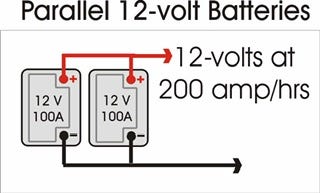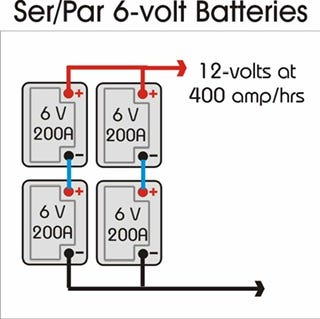Hey Mike,
I’m getting ready to pull our Motorhome out of storage for an Alaska trip this summer. It has three 12 volt deep cycle Group size 29DC batteries, which got down to very low charge two winters in a row. I’m going to replace them next week before our trip, but not sure which way to go. I recall something you discussed a while back about 6 volt versus 12 volt, series or parallel.
I was in Costco automotive the other day and noticed this display of 6 and 8 volt golf cart batteries. I’ve never heard of 8 volt systems, but they probably wouldn’t work in any combination for a 12 volt RV. After thinking about it I’m guessing they use 3 of them to somehow arrive at a 24 volt system?
We don’t normally drycamp, but the few times that we did we ran our internal generator. Only once or twice did we spend a night on battery power due to quiet hours. 2,000 watt inverter. I don’t want to use propane power for the refrigerator, and also run a CPAP.
My questions: Would 6 volt batteries be possible with only three instead of 4? Would that be an advantage over just staying with what I’ve got and replacing with three 12 volts units? Regular flooded acid or AGM?
I flew for the Navy and United for 40 years, and have a pretty good mechanical aptitude, but this electrical stuff makes my head hurt.
Thanks in advance. - Jim E
Hey Jim,
There’s only certain combinations of batteries that add up to the 12 volts needed for most RVs. Yes, some of the latest RVs come with 48-volt house batteries, but that’s a whole ‘nother story.
What you need
First, a quick review of the two battery parameters we’ll discuss today: Voltage and Amp/Hour capacity.
Voltage is simple, since it’s just a measure of electrical pressure and your RV wants 12 volts. Nope, 6 volts won’t work and 24 volts really won’t work for our RVs. We’re looking for 12 volts to power our DC systems, so that’s what we’ll cover here.
Amp-hour (Ah) capacity is basically how many amperes of current a battery can supply for an hour. So a 100 amp-hour battery can supply 100 amperes of current for 60 minutes before it’s totally exhausted. But you don’t want to discharge your lead-acid or AGM batteries much below 50% of capacity or you’ll really cut down their life span. So a 100 amp-hour battery has about 50 amp-hours of usable energy before it’s been depleted to a safe level.
How they add up…
When you connect batteries in series, the voltage adds together, but the Amp-hrs do not add. Here’s how a few series combinations work for your RV or a golf cart. Note that you’re only looking for combinations that produce 12 volts for your RV. As you guessed, some golf carts require 24 volts, which if what those 8 volt batteries are used for.
6 volts at 200 Ah + 6 volts at 200 Ah = 12 volts at 200 Ah (RV)
6 volts + 6 volts + 6 volts = 18 volts at 200 Ah
6 volts + 6 volts + 6 volts + 6 volts = 24 volts at 200 Ah (Golf Cart)
8 volts + 8 volts = 16 volts
8 volts + 8 volts + 8 volts = 24 volts (Golf Cart)
12 volts + 12 volts = 24 volts at 100 Ah (Golf Cart)
What about parallel batteries?
Batteries connected in parallel keep the same voltage, but the Amp-hr capacity is additive. You can connect 2, 3, 4 or more 12-volt batteries together in parallel.
12 Volts at 100 Ah + 12-Volts at 100 Ah = 12 Volts at 200 Ah
12 Volts at 100 Ah + 12-Volts + 12-Volts = 12 Volts at 300 Ah
12 Volts at 100 Ah + 12-Volts + 12-Volts + 12-Volts = 12 Volts at 400 Ah
Here’s series/parallel hookups
If you want to use more than two 6-volt batteries in your 12-volt RV, there’s only a few combinations that will work. You need to use 6-volt batteries in combinations of 2 batteries per stack. Then connect the stacks in parallel.
As you can see below, first we stack a pair of batteries in series to create 12 volts of potential, then put the series stacks in parallel so the Ah capacity doubles. So four of the 6-volt, 200-Ah batteries become a 12-volt/400-Ah battery bank with 4 times the capacity of a single 12-volt battery that came with your many RVs.
And I’ve seen a number or large coaches that use six 6-volt batteries in series/parallel to produce a 12-volt battery bank with 600 Ah of capacity. As long as you keep adding 6-volt batteries in pairs, you can connect even more pairs in parallel. So that’s 2, 4, 6 or 8 of 6-volt batteries stacked in series/parallel.
No, you can’t use three 6-volt batteries
There’s no way to make three 6-volt batteries in series add up to 12 volts, so that won’t work for you. And you can’t mix 6 and 12-volt batteries together. In fact, all batteries in these series/parallel combinations should be matched in brand, Amp-hr capacity and age.
That’s a wrap…
OK, everyone. Remember that electricity is a useful and powerful force, so we all need to pay attention to safety precautions while using it.
Let’s play safe out there…. Mike











I'd buy LiFePO4 at this point, much better return on investment, lighter, no worries about yhe 50% discharge, etc.
Mike, is there such a thing as a 6-volt AGM battery? I hate checking the water levels of my 4 FLA batteries, although they're on a tray, it doesn't slide out far enough to see the back batteries. I do use one of those plunger-style water dispensers to add distilled water.